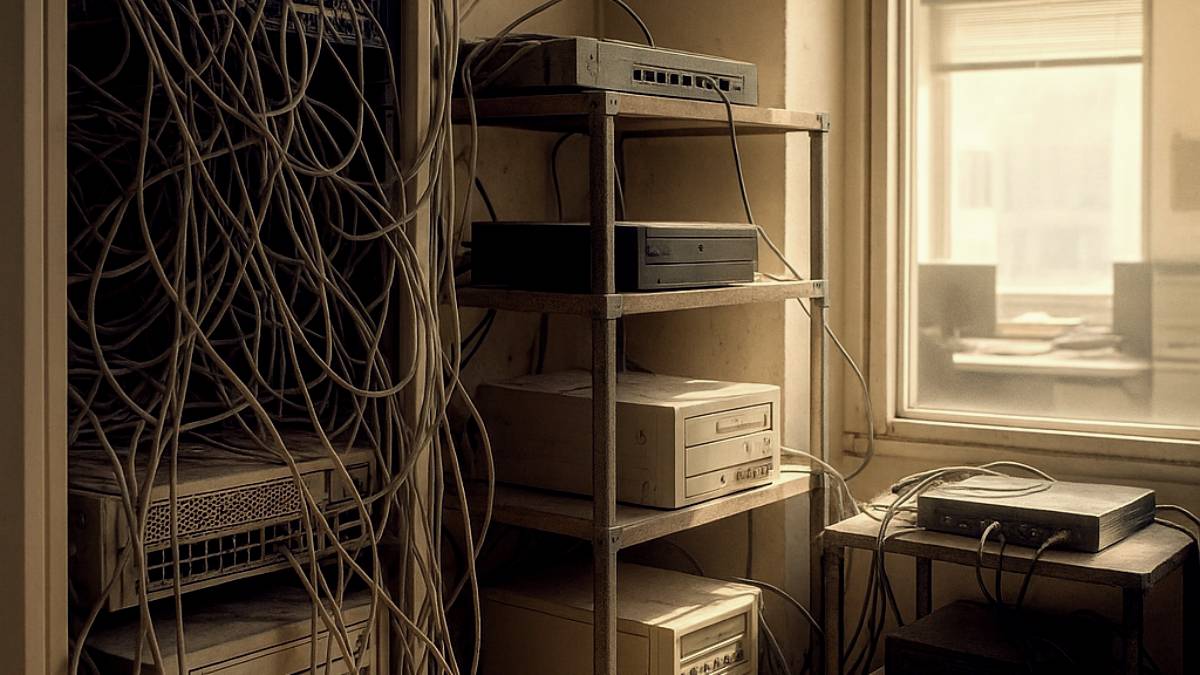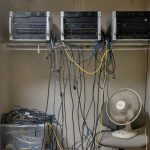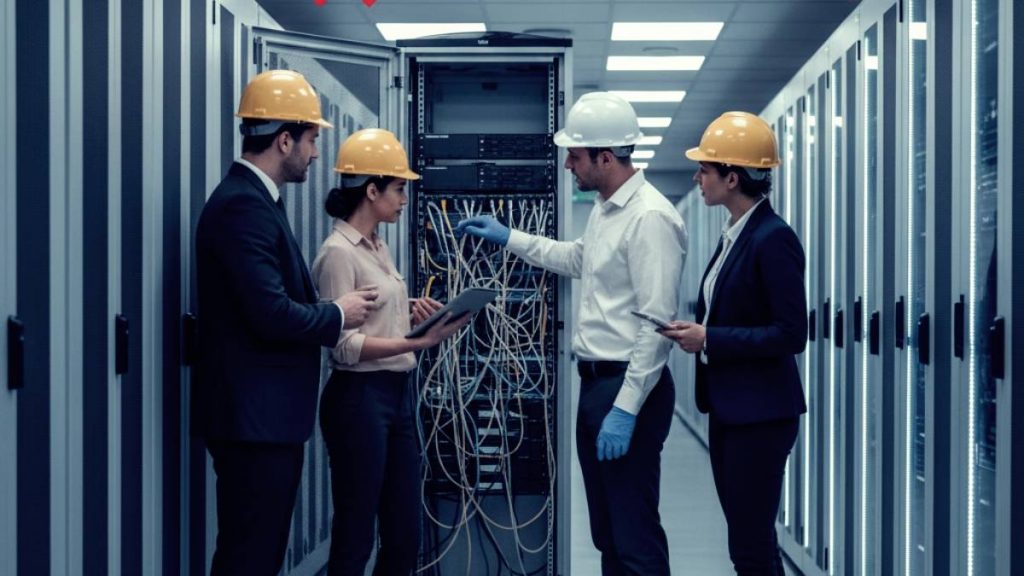
Think your servers are “reasonably safe” in a repurposed office closet or backroom? It’s a common belief, but let’s cut to the chase: office server rooms are notorious for dust bunnies, surprise water leaks, highly variable temperatures, unwanted critters, and (let’s be honest) occasional acts of clumsiness. Here’s how moving servers to a colocation data center gives your hardware and your business a huge leg up in the battle for reliable performance.
The Office Closet Trap: What’s Really Harming Your Servers
From the outside, an office server room might look adequate. But underneath the surface, these environments are full of silent hazards:
- Dust buildup from paper, HVAC, nearby printers, foot traffic, and dirty vents.
- Pests like insects and rodents, even in “nice” office parks.
- Temperature swings as buildings heat up or cool down on a whim.
- Humidity rising and falling with seasonal weather or faulty AC.
- Water and coffee spills (especially if your “server closet” doubles as a supply storage area).
- Unintentional bumps, knocks, or even the cleaning crew unplugging something vital.
These risks aren’t just annoyances: they’re leading causes of degraded hardware, random crashes, and, ultimately, expensive downtime.
Why Dust and Office Gunk Spell Disaster for Servers
Servers pull in room air to keep their components cool. Unfortunately, in a typical office, that air is rarely clean:
- Dust particles settle inside server chassis, insulate heat sinks, and scarf down fan lubrication. Result: airflow drops, heat rises, and electronics age faster.
- Sticky residues from cleaning chemicals or coffee spills create conductive paths, inviting component shorts.
- Fabric fibers and paper debris clog up intake filters, and static buildup from carpeted floors can zap delicate circuitry, sometimes without leaving a trace.
Data center providers know all of this. That’s why they engineer their environments to keep the unwanted out.
Purpose-Built Data Centers: Clean, Cool, and Critter-Free
Here’s how a professional data center environment immediately puts office setups to shame:
Precision Filtration and Air Handling
- Industrial-grade HEPA filtration keeps the air nearly particulate-free with far lower dust levels than any office.
- Positive pressurization means outdoor air (and anything floating in it) is forced out, not in.
- Strict access controls: no random foot traffic, deliveries, or after-hours events to stir the air or introduce debris.
Temperature and Humidity Always in the Goldilocks Zone
- Redundant, sensor-driven climate systems keep temperature steady (usually 68–72°F) and relative humidity at 45–55%. No wild swings to stress server boards, loosen memory modules, or warp plastics.
- Never “too dry” (which can cause static shocks) or “too humid” (asking for corrosion or mold). You can’t say that for your average office, especially over weekends or holidays.
Pests and Accidents: Not Here
- Professionally sealed environments and regular pest inspections make critters a non-issue.
- Flood and leak prevention is built into the physical design, with raised floors and industrial sensors. No waiting for someone to hear water dripping in a supply closet.
- No food, drink, mail, or janitorial carts allowed. Routine patrols and surveillance keep intruders of all stripes—animal, human, or otherwise—in check.
Comparative Table: Data Center vs. Office Server Room/Closet
| Risk/Factor | Office Server Room | Data Center Colocation |
|---|---|---|
| Dust & Debris | High — Uncontrolled environment, frequent buildup | Low — Professional filtration & cleaning |
| Heat & Cooling | Poor — Often insufficient or uneven cooling | Optimal — Purpose-built climate control |
| Humidity | Varies — Can fluctuate, risk to hardware | Managed — Stable humidity protects equipment |
| Pests & Rodents | Possible — Building pests risk cables & hardware | Rare — Proactive pest prevention protocols |
| Accidental Damage | High — Foot traffic, unsecured access | Minimal — Controlled, monitored facilities |
| Power Outages | Significant — Limited backup systems | Protected — Redundant power and backup |
| Physical Security | Low — Often just a locked door | High — Multi-layer physical security |
Why Clean Air (and Zero Critters) Means Higher Uptime
When your servers breathe easy, your business does too:
- Less dust = less heat. Hardware runs cooler, reducing thermal stress and avoiding random shutdowns due to overheating.
- No pests gnawing cables or nesting in racks. Chewed-through wiring and droppings are a real cause of sudden outages in office environments.
- Consistent climate = fewer hardware failures. Electronics (especially aging drives and power supplies) fail far less often when conditions don’t change erratically.
- Cleaner hardware lasts longer. Components accumulate less gunk, meaning less-frequent part failures and replacement cycles.
All of this translates directly to fewer unplanned outages, lower maintenance costs, and smoother business operations.
Colocation: The Path to Business Continuity and Peace of Mind
Downtime from environmental factors isn’t just a technical hiccup; it’s a business liability. Office server room incidents can lead to:
- Lost productivity during even short outages
- Data loss if equipment dies suddenly
- Customer dissatisfaction when services are unavailable
- Costly emergency IT calls to rescue or recover failed systems
Colocating your servers means handing these worries off to pros who live and breathe uptime:
- Constant server health checks and monitoring catch warning signs much earlier than ad hoc office inspections.
- Automatic failover and backup systems are standard in data centers—rarely so in an office closet.
- Physical and logical security is managed with layers of protocols, not just a “do not disturb” sign.
The result? Reliable access, robust backup, and higher confidence in your technology’s ability to support your goals, all without the shadow of mystery outages.
What Clients Notice After Moving to a Data Center
Businesses that shift from office closets to proper colocation nearly always notice the following:
- Fewer unexplained slowdowns or outages.
- Reduced replacement and repair costs as equipment lasts longer.
- Lower risk of compliance or data privacy incidents from environmental mishaps or unauthorized access.
- Peace of mind—IT staff and leadership spend less time firefighting and more time innovating.
Is Your Business Still Taking Office Server Risks?
If you’re still storing critical IT gear in a space that wasn’t built for it, you’re exposing your organization to risks that are largely preventable—and the solution is often more affordable than you’d think.
Want to see what a purpose-built data center could do for your uptime, costs, and peace of mind? Let’s chat about how Datacate can put your servers (and your business) in a safer place.







